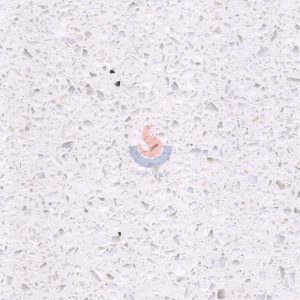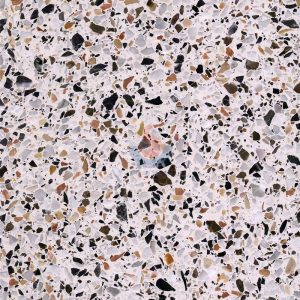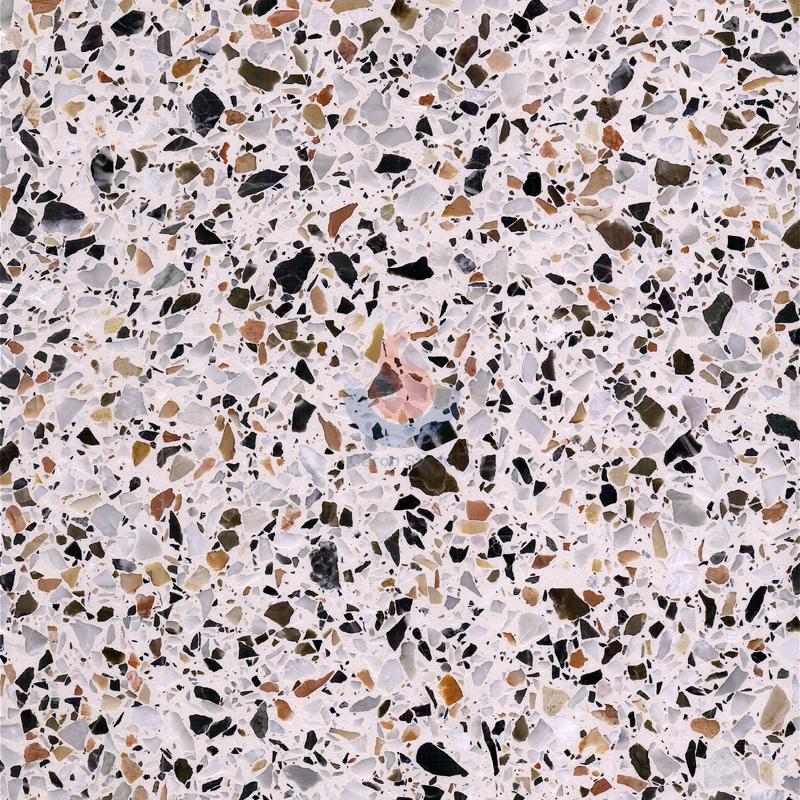Terrazzo, a once forgotten building material, now shines with new brilliance on the stage of the design world. With its unique texture and color, it redefines modern aesthetics and becomes a design element that emphasizes both fashion and function. From home furnishings to fashion, from architecture to art, the popularity of terrazzo patterns is not only a tribute to traditional craftsmanship, but also a pursuit of innovative spirit.

Terrazzo CRW225
Terrazzo Patterns
Re-popular
Time came to 2014. At the Milan International Furniture Fair, which is comparable to Paris Fashion Week in the home furnishing industry, British designer Max Lamb collaborated with material design studio DZEK to design a new type of terrazzo that shined.
It mixes three larger pieces of Italian marble fragments with 5% polyester resin. The new stone is stronger than natural marble and has more dreamy colors. The white one looks like nougat and the black one looks more like sesame candy.
Max Lamb named it Marmoreal. In the next few years, Marmoreal invaded European and American kitchens crazily, and traditional countertop materials were eclipsed by its beauty.
The fashion industry is also at the forefront of the terrazzo revival plan. In the same year, Valentino opened flagship stores in New York and Rome, designed by minimalist designer David Chipperfield.
The store uses a lot of terrazzo elements, and is matched with marble, brass, oak, etc., exposing the original material of the material, and can well set off the exhibits, creating an elegant and timeless atmosphere as a whole.
Since then, terrazzo has been widely sought after in the high-end fashion circle.
The YSL Museum in Marrakech is built with local terracotta, concrete and earth-colored terrazzo.
The Italian top luxury Valextra also invited Max Lamb to design the Hong Kong store.
Wes Anderson, director of “The Grand Budapest Hotel”, collaborated with PRADA to design the retro cafe Bar Luce.
In 2017, at the Bologna Exhibition in Italy, the Oscar of the architectural industry, more furniture with terrazzo elements attracted enough attention.
This trend immediately blew into China in the same year. In the Foshan Autumn Ceramics Fair in 2017, terrazzo tiles also became the main product of every company.
Therefore, the popularity of terrazzo is not a sudden collective nostalgia, but a premeditated plan led by design pioneers.
The acceptance of the trend by the mass market needs to be digested by the frontier. Terrazzo has been active in the high-end circle for four or five years before this trend blew to you and me.
From 2017 to 2018, the search volume of terrazzo on the foreign Xiaohongshu “Pinterest” surged by 316%, which is also consistent with the time when terrazzo was popular in our impression.
Compared with the simplicity we saw in the past, the terrazzo pattern is now more smart and playful, giving the space a jumping visual perception, like “colorful confetti for adults”.
What is more interesting is that terrazzo seems to have become a trend vane, and in addition to building materials, it is also radiating to other fields.
We can see all kinds of terrazzo patterned furniture, clothing, scarves, as small as napkins, straws, bowls and plates, and even nail art. They can be printed anywhere, and they can be co-branded with Supreme.
Some friends must have got it: rather than saying that terrazzo is popular again, the current situation is more like the resurgence of “terrazzo pattern”.
The revival of terrazzo is not only the return of a material, but also an innovation of design concept. Designers have given it more modernity and artistry through the reinterpretation and innovative application of terrazzo patterns.
In home design, the use of terrazzo is no longer limited to the floor or wall, but has been extended to furniture, decorations and even daily necessities such as lamps and vases. These design works add a different style to the living space with their unique textures and colors. In addition, the popularity of terrazzo patterns also reflects the pursuit of personalized and customized products by contemporary consumers. People begin to pay more attention to the design sense and cultural connotation of products, not just functionality.

Terrazzo CRW301
This trend is particularly evident among the younger generation, who are willing to pay for designs that can express personality and taste. The popularity of terrazzo patterns is a reflection of this consumer psychology. It is not only a visual enjoyment, but also an expression of a life attitude.





